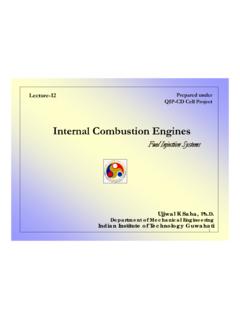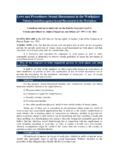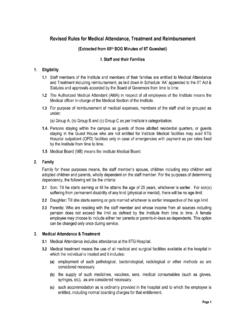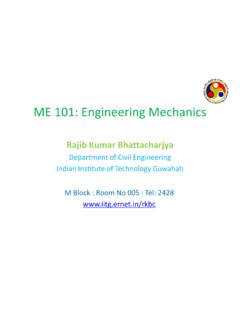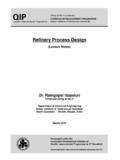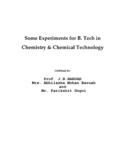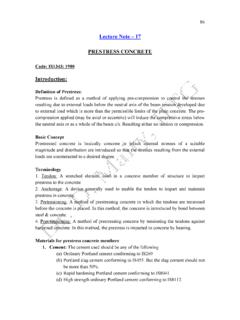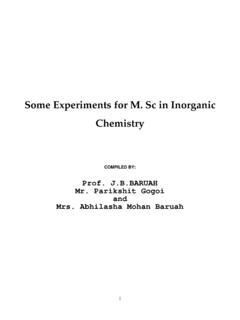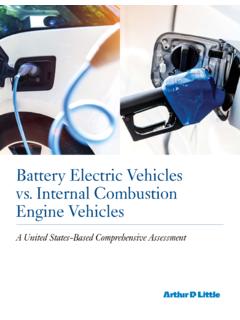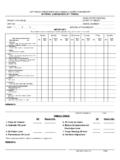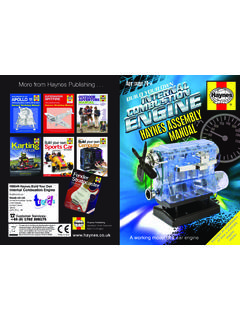Transcription of Internal Combustion Engines - iitg.ac.in
1 1 Internal Combustion EnginesLecture-16 UjjwalKSaha, of Mechanical EngineeringIndian Institute of Technology GuwahatiPrepared underQIP-CD Cell Project2 The Combustion in a spark ignition engine is initiated by an electrical discharge across the electrodes of a spark plug, which usually occurs from 100to 300before TDC depending upon the chamber geometry and operating conditions. Introduction The ignition system provides a spark of sufficient intensity to ignite the air-fuel mixture at the predetermined position in the engine cycle under all speeds and load In a four-stroke, four cylinder engine operating at 3000 rpm, individual cylinders require a spark at every second revolution, and this necessitates the frequency of firing to be (3000/2) x 4 = 6000 sparks per minuteor 100 sparks per second.
2 This shows that there is an extremely short interval of time between firing impulses. Introduction The Internal Combustion Engines are not capable of starting by themselves. Engines fitted in trucks, tractors and other industrial applications are usually cranked by a small starting engine or by compressed contd. Automotive Engines are usually cranked by a small electric motor, which is better known as a starter motor, or simply a starter. The starter motor for SI and CI Engines operates on the same principle asadirect current electric System -Requirements The system must distribute this high voltage to each of the spark plugs at the exact time in every cycle, , it must have in it a distributing device It should provide a good spark between the electrodes of the plugs at the correct timing The duration of the spark must be long enough with sufficient energy to ensure that ignition of the mixture has a high chance of occurring It should function efficiently over the entire range of engine speed It should be light.
3 Effective and reliable in service 6 One of the early ignition system employed was the glow plug ignition used in some kinds of simple Engines like model plug ignition A glow plug is a coil of nichrome wire that will glow red hot when an electric current is passed through ignites the air-fuel mixture upon coil is electrically activated from engine starting, and once it runs, it will retain sufficient residual heat on each stroke due to heat generated on the previous stroke. Glow plugs are also used to aid starting of diesel The other method used was the contact ignition. It consisted of a copper or brass rod that protruded into the cylinder, and was heated using an external source. Heat conduction kept the end of the rod hot, and ignition takes place when the combustible mixture comes into its this was very inefficient as the fuel would not be ignited in a controlled manner.
4 This type of arrangement was quickly superseded by spark ignition. Contact ignition8 The development of high speed, high compression Internal Combustion engine requires a reliable high-speed ignition system. This is met by a high-tension ignition system that uses a spark plug as the source of electrical energy to the spark plug is supplied by one of the following systems and is termed accordingly. Modern ignition ignition system ignition system ignition system9 CoilignitionswitchPrimarywindingSecondar ywindingDistributor contactsSpark plugs1234 DistributorcapacitorAmmeterBatteryContac tbreakerContact-breakeroperating camBattery ignition system10 Battery ignition system The primary circuit consists of the battery, ammeter, ignition switch, primary coil winding, capacitor, and breaker points. The functions of these components are:Battery: provides the power to run the systemIgnition switch: allows the driver to turn the system on and offPrimary coil: produces the magnetic field to create the high voltage in the secondary coilBreaker points: a mechanical switch that acts as the triggering mechanismCapacitor: protects the points from burning out11 Battery ignition system The secondary circuit converts magnetic induction into high voltage electricity to jump across the spark plug gap, firing the mixture at the right time.
5 The functions of the components are: Secondary coil : the part of the coil that creates the high voltage electricity Coil wire : a highly insulated wire to take the high voltage to the distributor cap Distributor cap : a plastic cap which goes on top of the distributor, to hold the high tension wires in the right order Rotor : spins around on the top of the distributor shaft, and distributes the spark to the right spark plug Spark plug leads : another highly insulated wire that takes the high voltage from the cap to the plugs Spark plugs: take the electricity from the wires, and give it an air gap in the Combustion chamber to jump across, to light the mixture12 Magneto ignition system The high powered, high speed spark ignition Engines like aircraft, sports and racing cars use magneto ignition system. The basic components of a magneto ignition system consist of a magneto, breaker points, capacitor, ignition switch, distributor, spark plug leads, and spark plugs.
6 Magneto can either be rotating armaturetype or rotating magnetotype. In the former, the armature consisting of the primary and secondary windings all rotate between the poles of a stationary magneto, while in the second type, the magneto revolves and the windings are kept stationary. 13 CoilDistributorSpark plugsPrimary windingSecondary windingRotating magnet (two-pole)CamContact- breakerCapacitorIgnitionswitchMagneto ignition system(with rotating magnets)14 Electric Circuit Uses a changing magnetic field to generate current in primary and secondary circuits15 As magnet approaches, induces magnetic flux in armature Breaker points close and current dissipates through primary circuitMagnetic Flux16 After magnet rotates past armature flux reverses direction, and the breaker points open Change in magnetic flux produces 170 volts in primary circuit Induces 10,000 volts in secondary circuit, firing spark plugSpark Fires17 Crankshaft rotation causes mechanical actuation of breakerBreaker Points18 Electronic ignition system The disadvantage of the mechanical system is that it requires regular adjustment to compensate for wear, and the opening of the contact breakers, which is responsible for spark timing, is subject to mechanical variations.
7 In addition, the spark voltage is also dependent on contact effectiveness, and poor sparking may lower the engine efficiency. Electronic ignition system has solved these problems. 19 SwitchIgnition coilElectroniccontrol unitSpark plugs1234 DistributorArmatureSensor coilBatteryElectronic ignition system20 Electronic ignition system contd. In this system, the contact breaker points are replaced by an angular sensor of some kind -either optical, where a vaned rotor breaks a light beam, or more commonly using a hall effectsensor, which responds to a rotating magnet mounted on a suitable shaft. The sensor output processed by a suitable circuitry is then used to trigger a switching device such as a thyristor, which switches a large flow of current through the coil. 21 Electronic ignition system contd. The rest of the system (distributor and spark plugs) remains the same as that of the mechanical system.
8 The lack of moving parts compared with the mechanical system leads to greater reliability and longer service intervals. In some older cars, it was usually possible to retrofit an electronic ignition system in place of the mechanical coilElectroniccontrol unitSpark plugs1234 DistributorArmatureSensor coilBattery22 Spark Plugs The spark plug ignites the air-fuel mixture inside the cylinder. This occurs when high voltage, triggered at precisely the right instant, bridges the gap between the center and the ground electrodes. It also provides a secondary purpose of helping to channel some heat away from the A cold plug has the advantage of quicker heat transfer. It has a shorter insulator, and thereby allowing heat to travel a shorter distance.
9 (a) Cold plug(b) Hot plug A hot plug has a longer insulator, and therefore, heat travel path from firing tip to electrode is longer. This enables it to operate at higher temperature to compensate for the cooler running engine. 24 Firing Order Firing order indicates the sequence or order in which the firing impulses occur in a multi-cylinder spark ignition engine. It is chosen to give a uniform torque, and hence a uniform distribution of firing per revolution of the engine. This is naturally dictated by the engine design, the cylinder arrangement and the crankshaft design. The firing order be such that there must always be a proper balance so as to minimize the engine vibration. 25 Firing Order As for example, in a four-stroke, four-cylinder engine, the firing or the ignition in all the cylinders has to be completed in two revolutions of the crankshaft.
10 With crank throws at 1800, the cylinders 1 and 4 will reach TDC at the same time. Now, if the firing interval is made by 1800, the firing in cylinder-1 cannot be followed by the same reason, the firing of cylinder-2 cannot be followed by cylinder-3. As such, the possible sequence is 1-2-4-3 or 1-3-4-2. 26 Firing Order Consider another example of four-stroke, six-cylinder inline engine, where cranks are set at 1200, and with the cylinders 1-6, 2-5 and 3-4 will reach TDC simultaneously. Here, the possible sequence is 1-5-3-6-2-4 or radial Engines , the cylinders are usually numbered consecutively. Thus, for a seven-cylinder radial engine, the sequence is 1,3,5,7,2,4,6. WH, Crouse WH, andandAnglin DLAnglin DL, (1985),Automotive Engines ,Tata McGraw TD, Eastop TD, andandMcConkey A,McConkey A,(1993),Applied Thermodynamics for Engg.
